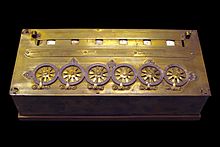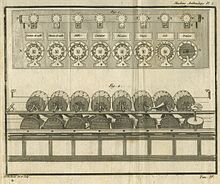
Back آلة باسكال الحاسبة Arabic Pascalina Catalan Pascalina Czech Pascaline German Paskala kalkulilo Esperanto Pascalina Spanish ماشین حساب پاسکال Persian Pascaline French מכונת החישוב של פסקל HE Pascalina Croatian


Pascal's calculator (also known as the arithmetic machine or Pascaline) is a mechanical calculator invented by Blaise Pascal in 1642. Pascal was led to develop a calculator by the laborious arithmetical calculations required by his father's work as the supervisor of taxes in Rouen.[2] He designed the machine to add and subtract two numbers directly and to perform multiplication and division through repeated addition or subtraction.
Pascal's calculator was especially successful in the design of its carry mechanism, which adds 1 to 9 on one dial, and carries 1 to the next dial when the first dial changes from 9 to 0. His innovation made each digit independent of the state of the others, enabling multiple carries to rapidly cascade from one digit to another regardless of the machine's capacity. Pascal was also the first to shrink and adapt for his purpose a lantern gear, used in turret clocks and water wheels. This innovation allowed the device to resist the strength of any operator input with very little added friction.
Pascal designed the machine in 1642.[3] After 50 prototypes, he presented the device to the public in 1645, dedicating it to Pierre Séguier, then chancellor of France.[4] Pascal built around twenty more machines during the next decade, many of which improved on his original design. In 1649, King Louis XIV of France gave Pascal a royal privilege (similar to a patent), which provided the exclusive right to design and manufacture calculating machines in France. Nine Pascal calculators presently exist;[5] most are on display in European museums.
Many later calculators were either directly inspired by or shaped by the same historical influences that had led to Pascal's invention. Gottfried Leibniz invented his Leibniz wheels after 1671, after trying to add an automatic multiplication feature to the Pascaline.[6] In 1820, Thomas de Colmar designed his arithmometer, the first mechanical calculator strong enough and reliable enough to be used daily in an office environment. It is not clear whether he ever saw Leibniz's device, but he either re-invented it or utilized Leibniz's invention of the step drum.
- ^ Œuvres de Pascal in 5 volumes, La Haye, 1779
- ^ Magazine Nature, (1942)
- ^ Falk, Jim (November 14, 2014). "Blaise Pascal's Pascaline". Things that Count. Retrieved January 31, 2016.
- ^ (fr) La Machine d’arithmétique, Blaise Pascal, Wikisource
- ^ Guy Mourlevat, p. 12 (1988)
- ^ Leland Locke, p. 316 (1933)
© MMXXIII Rich X Search. We shall prevail. All rights reserved. Rich X Search